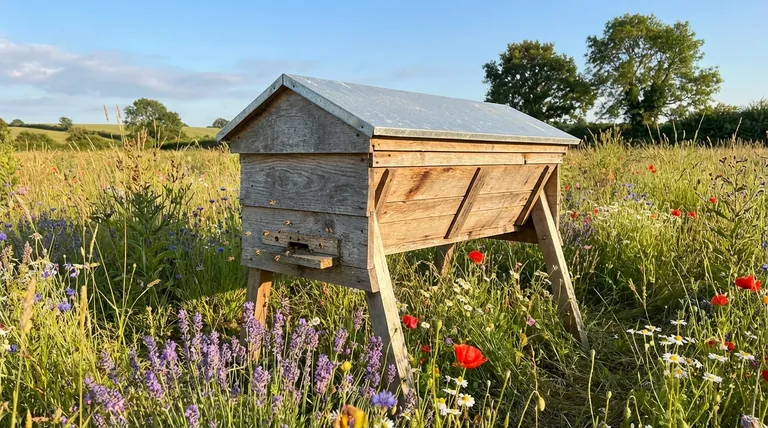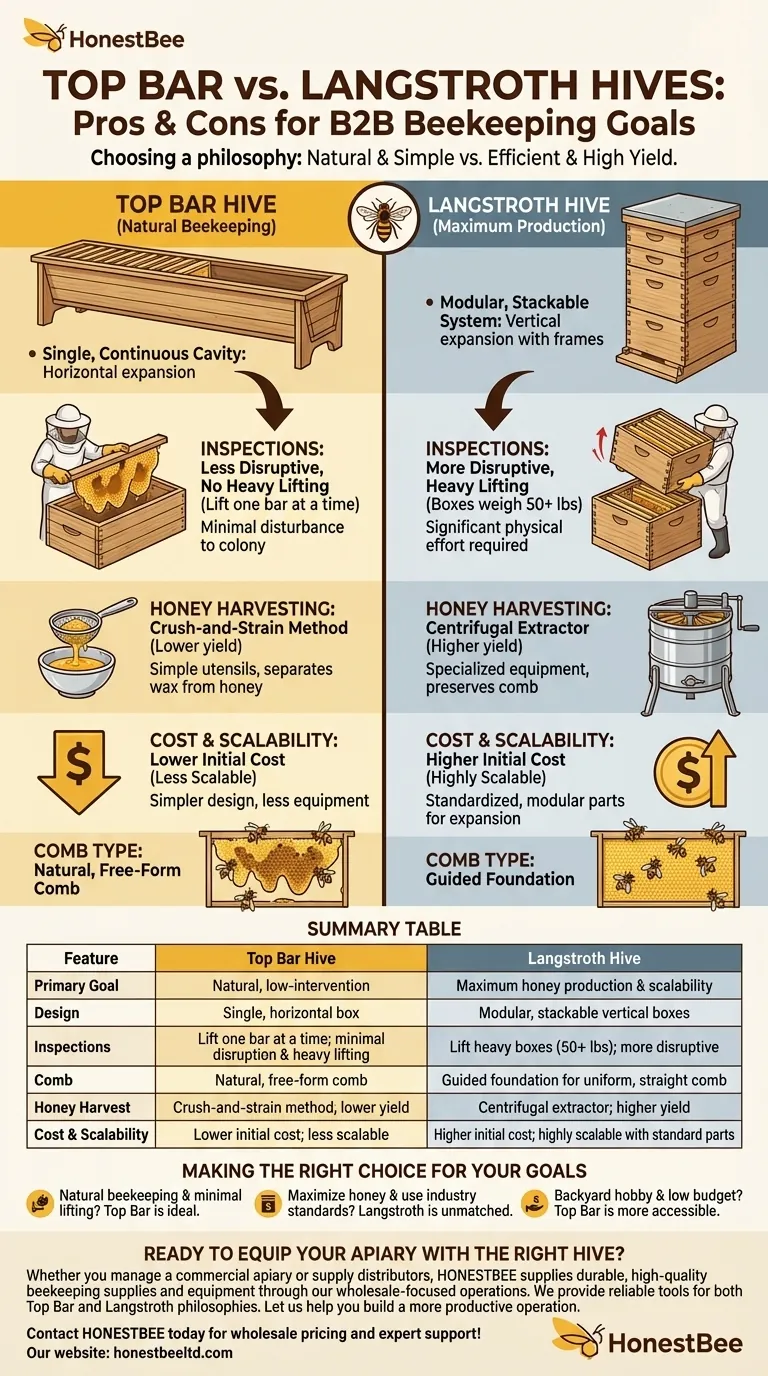At their core, the choice between a Top Bar Hive and a Langstroth Hive comes down to your primary goal. Top Bar Hives are designed for a more natural, less intrusive style of beekeeping with minimal heavy lifting, making them ideal for hobbyists. In contrast, Langstroth hives are the industry standard, engineered for maximum honey production and scalability through a modular, multi-box design.
The decision is not about which hive is objectively "better," but which philosophy aligns with your beekeeping goals. You are choosing between a system that prioritizes simplicity and natural bee behavior (Top Bar) and one that prioritizes efficiency and honey yield (Langstroth).

Foundational Design: Horizontal vs. Vertical
The most significant difference between these two hives is their fundamental structure. This design distinction dictates how you manage the bees, inspect the colony, and harvest honey.
The Top Bar Hive: A Single, Continuous Cavity
Top Bar Hives have a long, horizontal layout, resembling a trough. The top is covered with individual bars that the bees build their comb down from naturally.
This is a self-contained, single-box system. The colony expands horizontally along the bars rather than vertically into new boxes.
The Langstroth Hive: A Modular, Stackable System
The Langstroth hive is the familiar stack of vertical boxes. It consists of a bottom board, multiple boxes for the brood (where the queen lays eggs) and honey supers (for honey storage), and a lid.
Bees build their comb on removable frames inside these boxes. This modularity allows the beekeeper to add or remove boxes to give the colony more or less space as needed throughout the season.
The Beekeeper's Experience: Management and Inspection
Your day-to-day interaction with the bees will feel remarkably different depending on the hive you choose. This is especially true when it comes to colony inspections.
Inspecting a Top Bar Hive
Inspections are less disruptive and physically demanding. You inspect the colony by lifting out one bar at a time, leaving the rest of the hive undisturbed and calm.
Because you are only lifting a single comb, there is no heavy lifting involved, which is a significant advantage for many beekeepers.
Inspecting a Langstroth Hive
To inspect the brood chamber in a Langstroth hive, you must first lift off the upper honey supers. These boxes can weigh 50 pounds or more when full of honey.
This process is more disruptive to the entire colony and requires significant physical strength.
Understanding the Trade-offs
Neither hive is perfect. The advantages of one system are often the direct disadvantages of the other. Understanding these trade-offs is crucial to making the right choice.
Natural Comb vs. Guided Foundation
Top Bar Hives encourage bees to build natural, free-form comb from a simple starter strip on each bar. This is a core principle of the "natural beekeeping" philosophy.
Langstroth hives typically use frames with pre-made wax or plastic foundation imprinted with a hexagon pattern, which guides the bees to build straight, uniform combs for easier extraction.
Honey Harvesting and Yield
Harvesting from a Top Bar hive is simple. You cut the comb off the bar and use a crush-and-strain method with basic kitchen utensils to separate the honey from the wax. However, overall honey production is generally lower.
Langstroth hives are designed to maximize honey yield. Harvesting involves specialized—and often expensive—equipment like hot knives to uncap the cells and a centrifugal extractor to spin the honey out. This process preserves the drawn-out comb, which bees can refill more quickly.
Initial Cost vs. Scalability
The initial cost of a Top Bar Hive is lower. The design is simpler, and you do not need to purchase expensive extraction equipment.
While a Langstroth hive costs more upfront, its standardized, modular parts make it highly scalable. It's easy to find compatible equipment from any beekeeping supplier if you want to expand your operation.
Making the Right Choice for Your Goals
Your personal goals should be the deciding factor. The best hive is the one you will enjoy managing and that fits your physical abilities and beekeeping philosophy.
- If your primary focus is natural beekeeping with minimal heavy lifting: The Top Bar hive's simple design and less intrusive inspections make it the clear winner.
- If your primary focus is maximizing honey production and using industry-standard equipment: The Langstroth hive's efficiency and scalability are unmatched.
- If your primary focus is a backyard hobby with a low initial budget: The Top Bar hive is often the more accessible and affordable starting point.
Ultimately, understanding these core differences in design and philosophy empowers you to select the hive that best serves both you and your bees.
Summary Table:
| Feature | Top Bar Hive | Langstroth Hive |
|---|---|---|
| Primary Goal | Natural, low-intervention beekeeping | Maximum honey production & scalability |
| Design | Single, horizontal box | Modular, stackable vertical boxes |
| Inspections | Lift one bar at a time; minimal disruption & heavy lifting | Lift heavy boxes (50+ lbs); more disruptive |
| Comb | Natural, free-form comb | Guided foundation for uniform, straight comb |
| Honey Harvest | Crush-and-strain method; lower yield | Centrifugal extractor; higher yield |
| Cost & Scalability | Lower initial cost; less scalable | Higher initial cost; highly scalable with standard parts |
Ready to Equip Your Apiary with the Right Hive?
Whether you manage a large commercial apiary or supply beekeeping equipment to distributors, choosing the right hive is the first step to success. HONESTBEE supplies durable, high-quality beekeeping supplies and equipment through our wholesale-focused operations.
We provide the reliable tools you need to support both Top Bar and Langstroth beekeeping philosophies. Let us help you build a more productive and efficient operation.
Contact HONESTBEE today for wholesale pricing and expert support!
Visual Guide

Related Products
- Long Langstroth Style Horizontal Top Bar Hive for Wholesale
- HONESTBEE Professional Multi-Functional Hive Tool with Ergonomic Wood Handle
- HONESTBEE Professional Long Handled Hive Tool with Precision Cutting Blade
- Langstroth Bee Hives Bee Keeping Box for Beginners Beekeeping
- HONESTBEE Advanced Ergonomic Stainless Steel Hive Tool for Beekeeping
People Also Ask
- How does the design of a top bar hive benefit beekeepers? Ergonomic & Natural Beekeeping for Hobbyists
- What are the main differences between Langstroth hives and top bar hives? Choose the Right Hive for Your Beekeeping Goals
- What are the box management requirements for a top bar hive vs. Langstroth? Choose Your Hive Strategy
- What are the benefits of a top bar hive? A Natural, Low-Impact Approach to Beekeeping
- What are the advantages of a top bar hive? Simpler, Bee-Centric Beekeeping for All



















